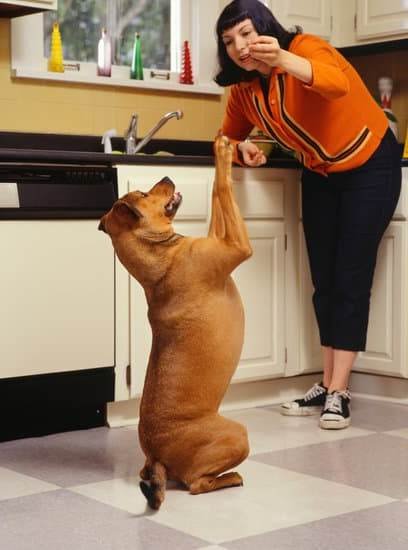Introduction
Training your dog basic commands allows you to form a positive bond with your pet while teaching them important skills. This can give you both a greater sense of trust and respect as they become more confident and comfortable around you. A well-behaved pooch is one that is properly trained. Having a well-trained dog not only makes them easier to handle, but it encourages safety for when taking them out for walks or trips in the car.
The main key to training any animal, especially dogs, is developing a strong relationship with your dog based on trust and mutual respect. To do this, it’s important to create consistent rules that you expect your pup to adhere to. When teaching commands such as “sit”, “stay” or “down”, use positive reinforcement methods like verbal praises and treats rather than punishment when they fail to comply. It’s also useful to incorporate hand gestures while commanding your pup since body language can be an effective way of training animals. Lastly, practicing the same commands multiple times throughout the week will help reinforce their understanding until the command becomes instinctive behaviour for them.
In additon to reinforcing positive behaviour through rewards and repetition, it is essential that pets also receive sufficient exercise in order for them to behave better. Take them out on regular walks and give them some room where they can run freely at least once per day while they are still young and growing so they get used to human commands from an early age. This extra activity may even lead to fewer behavioural issues down the line as energy needs are being met regularly throughout their growth phase! Building trust with your dog goes beyond simply providing food and medical care; ensure you spend plenty of quality time together so your pup gets accustomed to you being around on a daily basis — this increases comfort levels which ultimately leads to better listening during training sessions!
Benefits of Training Your Dog
Training your dog provides a variety of benefits for both the owner and the dog. It gives owners control over their pet’s behavior and adds structure to the relationship. By teaching obedience commands, owners have more control and can be aware of any potentially dangerous situations. Training also strengthens the bond between owner and dog, reducing stress in both parties.
Ongoing training is essential for creating a healthy, balanced relationship between pet and pet parent. By setting expectations and providing rewards for following directions, dogs learn appropriate behavior and feel secure in their environment. As an added bonus, training reinforces key skills more effectively than most methods of discipline that may cause fear or distress in a pet.
Not only does training help create a better environment for an animal but it also lets us understand our canine companion’s body language. Knowing when to come or stay away allows pets greater freedom while still obeying commands from their parents. Another benefit is improved socialization with other dogs, guests in the home, or strangers who might otherwise pose a threat to the family. Lastly, basic commands can teach a dog manners so they know not jump up on people, pull on leashes during walks, or make too much noise.
Understanding Your Dog
When training your dog basic commands, it is important to make sure you understand their unique personality, so that you can best develop a positive relationship with them. Consider the individual needs of your pet as an individual rather than assuming all dogs will respond in the same way. Make sure you are aware of factors such as age and breed type, as these larger picture elements can influence the most effective methods for training. Knowing and understanding your dog’s specific traits and needs will help guide the way towards effective dog training.
Set Clear Expectations – Development clear expectations when training your dog is paramount to successful communication between you and them. Make sure that your verbal commands are precise and consistent, and utilize hand signals based on tasks with start or stop commands. Be mindful that dogs may not understand humans in the same manner that humans might understand each other. Having detailed expectations helps set a standard for what you are trying to achieve together during the course of your training session.
Positive Reinforcement – Utilizing rewards such as treats or toys can be invaluable when teaching your dog new behaviors or commands. Positive reinforcement helps reinforce behaviors by rewarding desired actions, which in turn creates greater motivation for them to learn . Be sure to provide visible cues either verbally or through relevant gestures when acknowledging particular behaviors through providing positive reinforcement. Doing this effectively will not only aid in teaching a desirable behavior but also strengthen the bond between you and your pet while doing so!
Basic Training Commands & Guidelines
The first key to training your dog is to establish a positive relationship between yourself and the pup. Commence by reinforcing positive behavior, including getting them used to having their leash worn and taking them for regular walks.
Once a connection has been established it is beneficial to initiate the use of basic commands such as “sit”, “stay”, “come” and “down”. Be sure to reward your pet’s correct responses with treats or verbal praises. When training your pup, it is important to remain calm and consistent while also keeping lessons short and fun. Make sure you are repeating commands multiple times in each session so that you do not get frustrated during training sessions and discouragement creeps in on either side of the relationship. If your pooch remains unresponsive or confused when following instructions remember patience is key – reinforcement takes time!
When teaching more complex commands like ‘heel’ or other trick behaviors (roll over, shake hands etc) try different approaches such as breaking down these maneuvers into easier parts that can be taught separately before moving on to putting everything together for a command such as ‘heel’. You may also find success using clicker training; clickers create an association in Fido’s mind between good behavior and subsequent rewards giving him a cue when desired behaviors have been completed that bridges the gap between action and reward making it easier for him to understand what is expected from him.
Positive Reinforcement
Positive reinforcement is an essential part of training your dog basic commands. To have a successful learning experience, it’s important to reward your pup for following the commands you’ve taught them and praise their successes. This reinforces positive behavior, builds up their confidence and engenders a great relationship between dog and owner.
The most important thing to remember while using positive reinforcement is that rewards should be given immediately after the desired action so your pup can make the connection between their success and the reward. You could start off rewarding them with tasty treats like liver treats or cheese cubes, but as they progress it’s also beneficial to reward them with verbal recognition, petting, playing or brushing. Mastering different commands may take time for some dogs – in these cases, it is important to recognize small steps along the way with positive feedback as this will make learning easier and more enjoyable.
By properly training your dog basic commands with positive reinforcement, you are setting your furry friend up for success while fostering a strong bond between you both.
Multimedia Resources
When it comes to basic commands for training your dog, audio and visual resources are key. Having access to multimedia resources can be invaluable when teaching your pup the basics like ‘sit’, ‘stay’, and ‘down’. Videos that demonstrate how to give these simple commands with clarity and in context can help make the learning process smoother. Additionally, photos of dogs in various poses while performing commands can also provide useful cues when teaching your pup the essentials. With both audio-visual aids, you can have a better understanding of how each command should be given and demonstrated in full. This would aid owners and their furry friends by creating easier to understand instructions that yield faster results in obedience training. Not only will multimedia aides help you feel more confident in training but they could also make the whole learning experience much more enjoyable for both you and your pup!
Conclusion
Training your dog is essential for establishing a strong bond between the two of you. By taking the time to teach your pet basic commands, you can help foster an obedient and trusting relationship. Training will also promote positive behaviors in your pet which will help them be better behaved when out with other people and pets. Additionally, training helps to provide mental stimulation for your pup and can help prevent boredom. It’s important to keep up with your pet’s progress so that they have a solid foundation of commands that they can easily understand. Utilize reward-based training techniques as often as possible so that you’re reinforcing desired behaviors, rather than punishing bad behavior. Furthermore, be consistent with commands across different environments – such as indoors and outdoors – and make sure everybody who works with your pet knows the same set of commands so that the rules stay consistent. Ultimately, training your dog is not only important for teaching them basic commands but it’s also helpful in creating a bond built on trust

Welcome to the blog! I am a professional dog trainer and have been working with dogs for many years. In this blog, I will be discussing various topics related to dog training, including tips, tricks, and advice. I hope you find this information helpful and informative. Thanks for reading!





